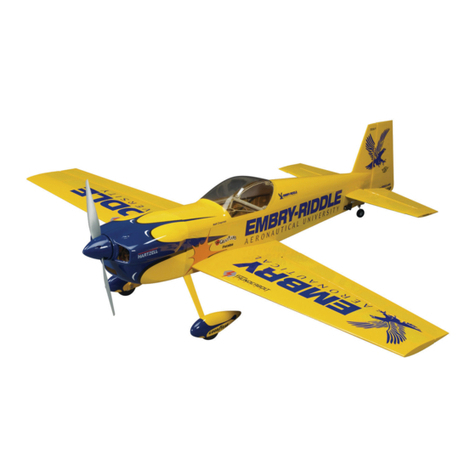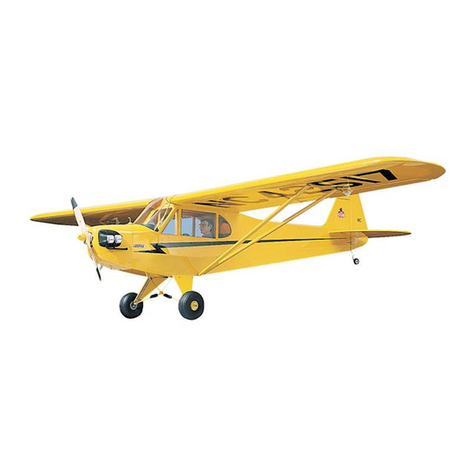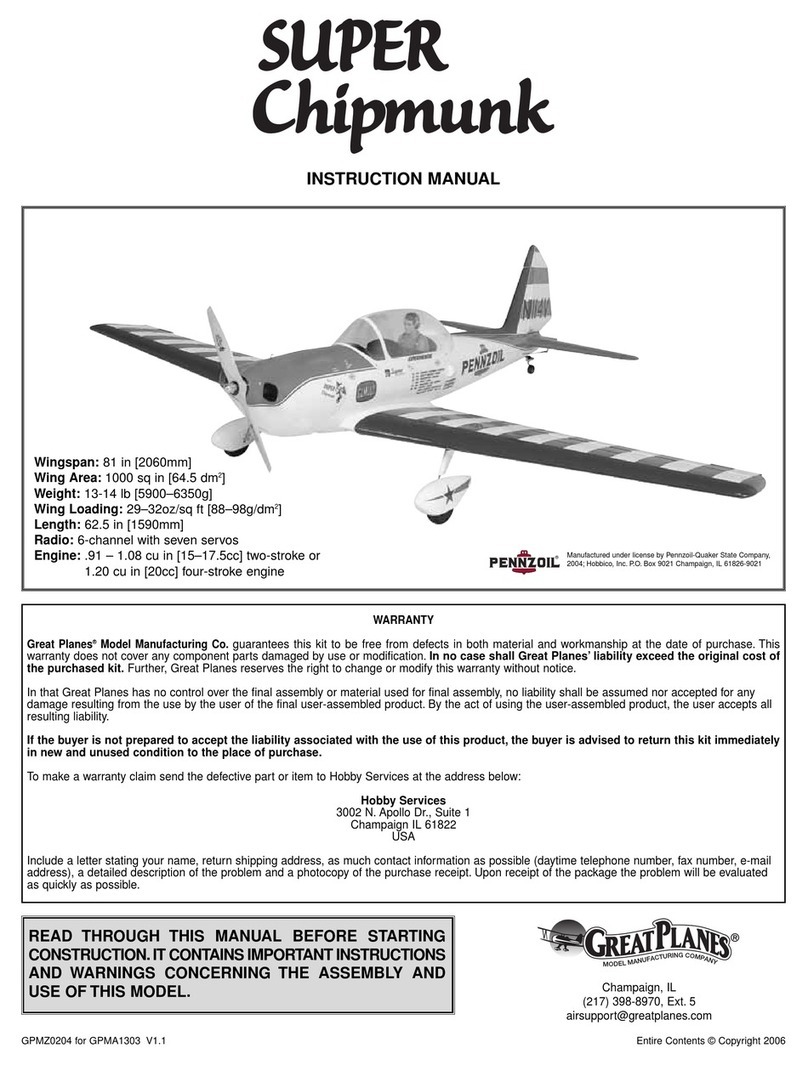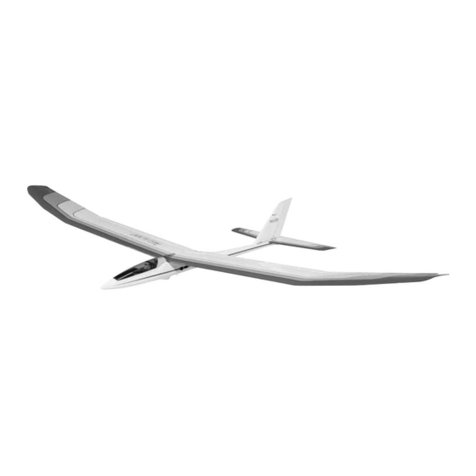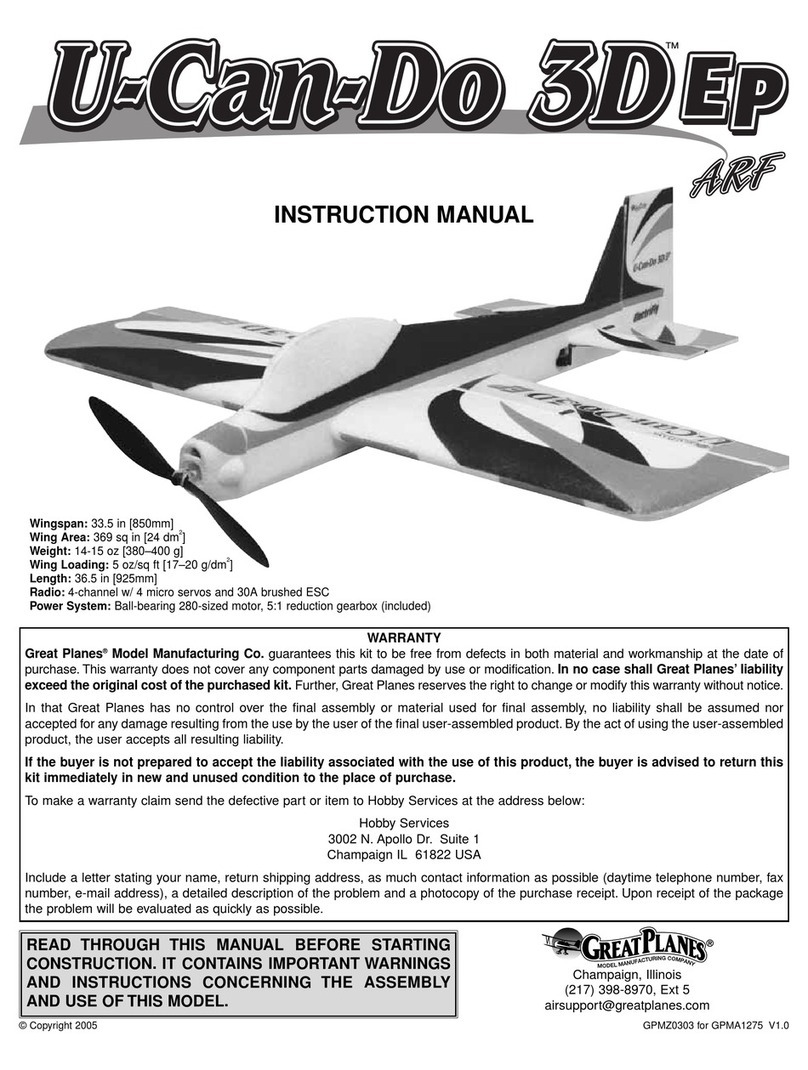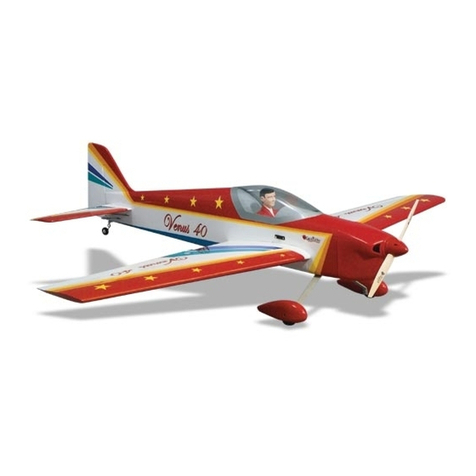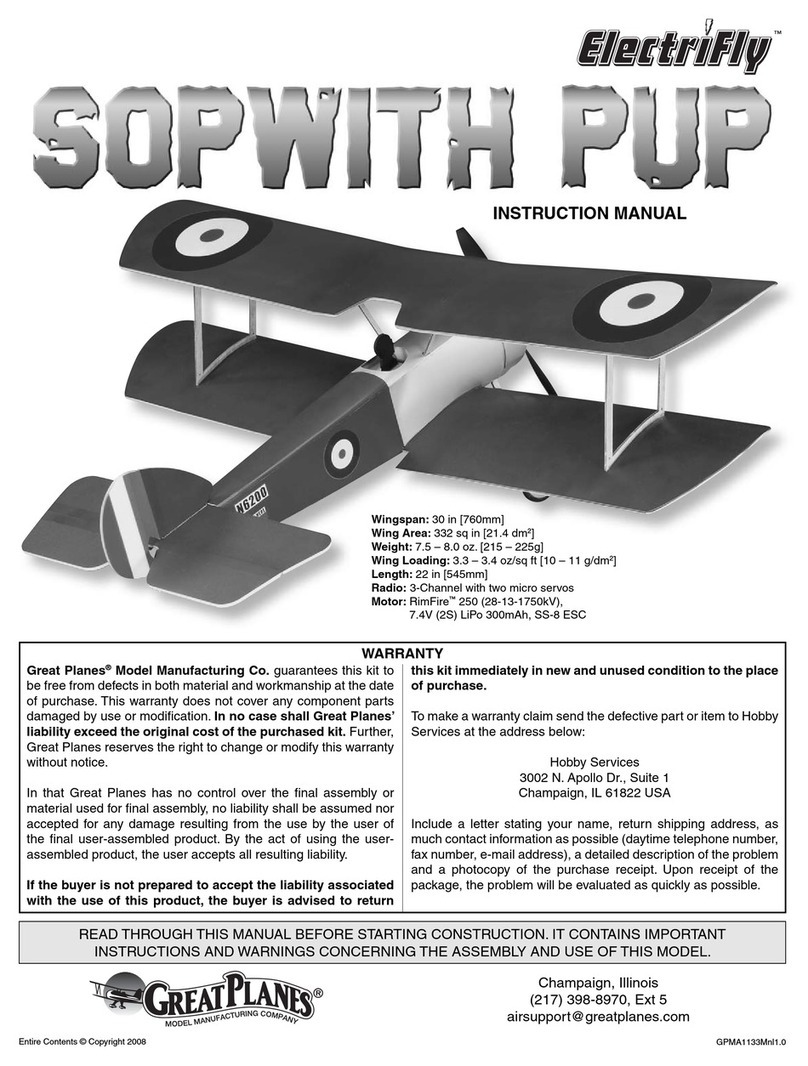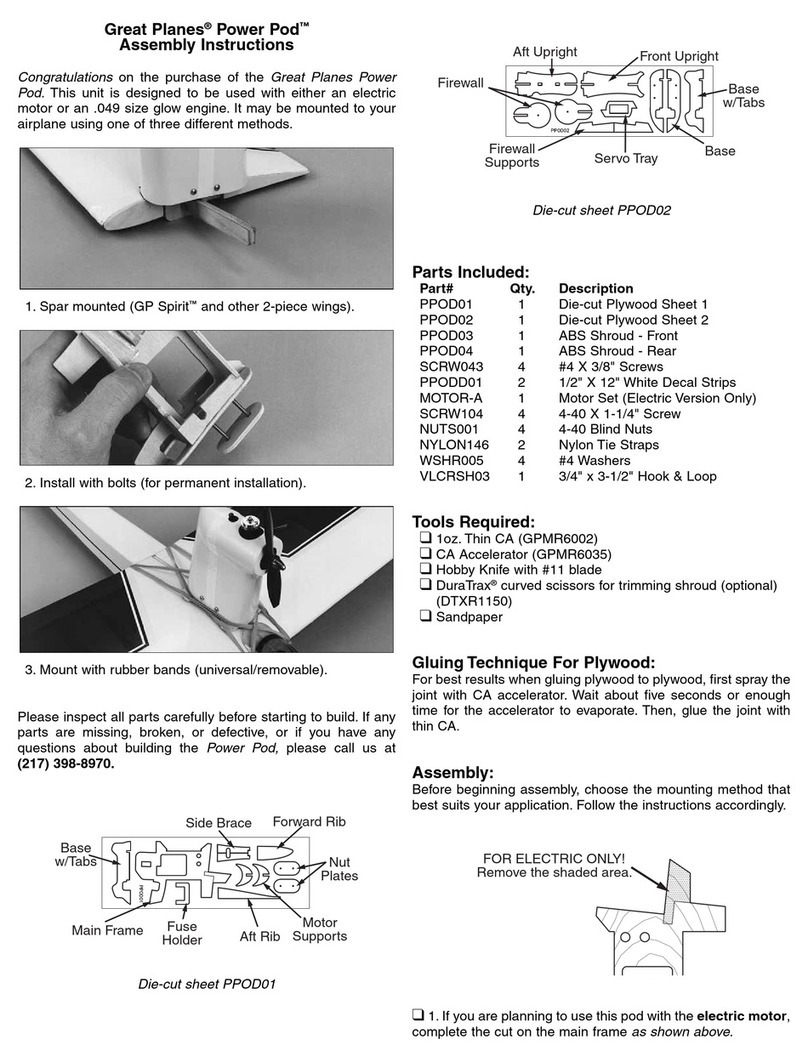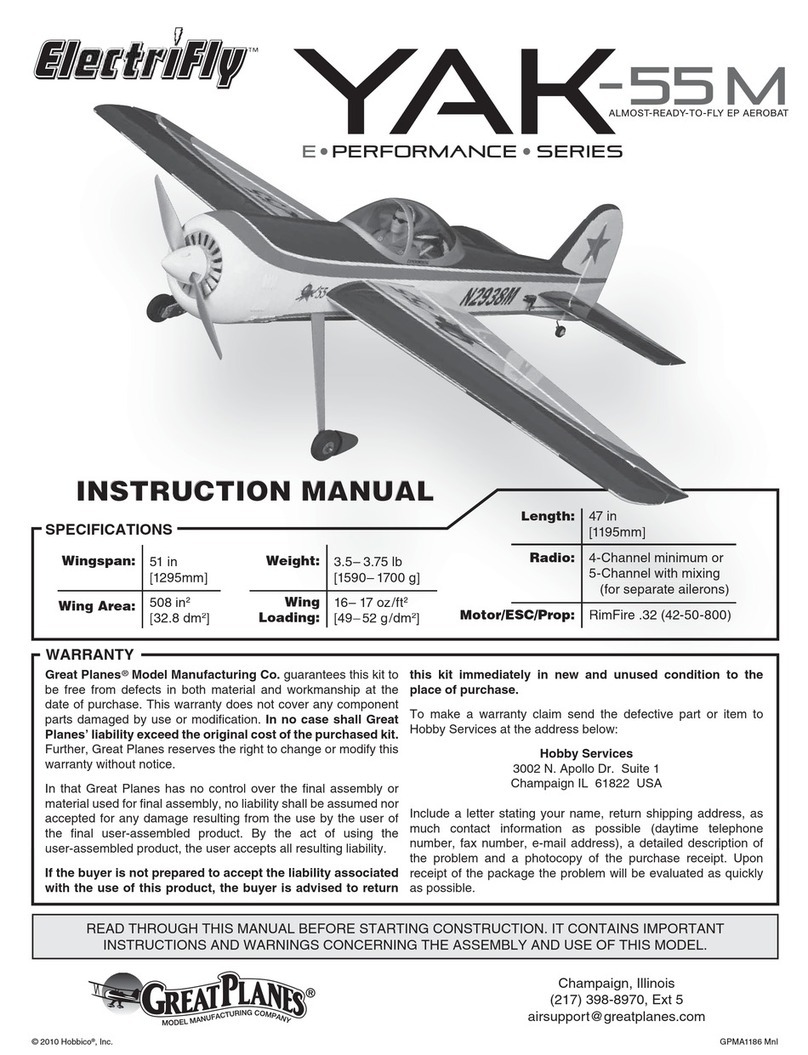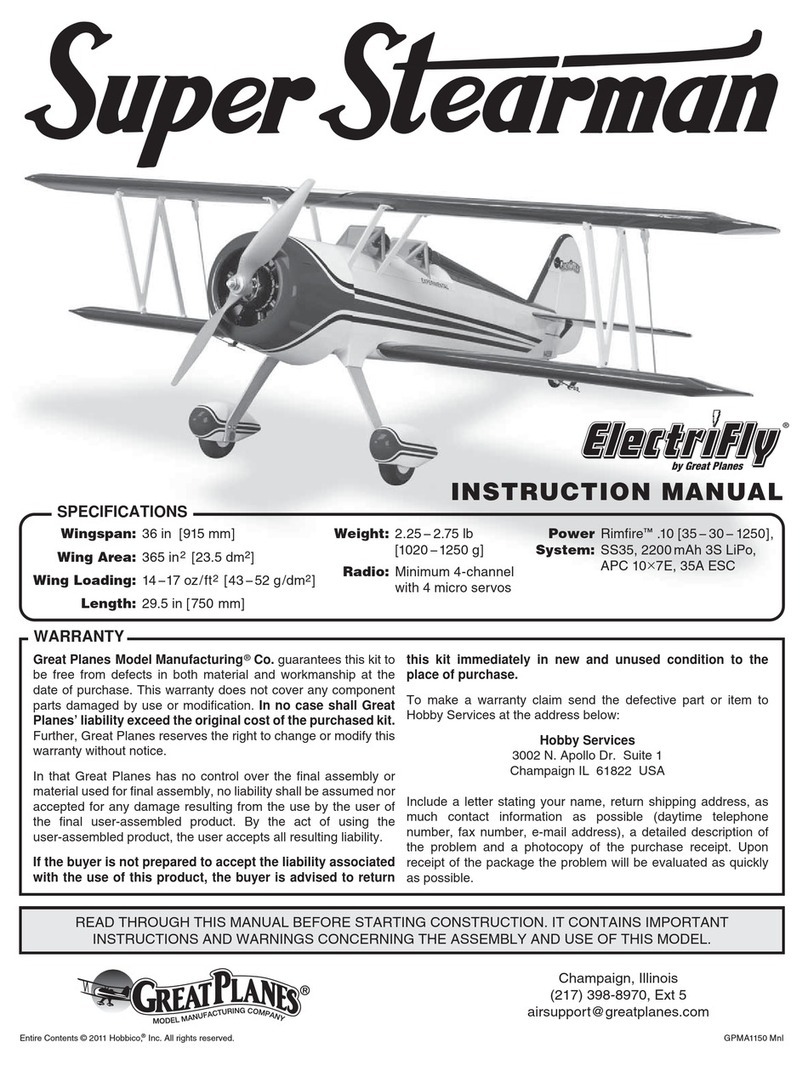
2
INTRODUCTION
The Factor 3D EP ARF was designed from the ground up to
provide one of the best flying 3D airplanes available today.
Whether you are just learning to fly 3D or are already an
expert, you will love this airplane.
For the latest technical updates or manual corrections to the
Factor 3D EP ARF visit the Great Planes web site at www.
greatplanes.com. Open the “Airplanes” link, and then select
the Factor 3D EP ARF. If there is new technical information
or changes to this model a “tech notice” box will appear in the
upper left corner of the page.
Academy of Model Aeronautics
We urge you to join the AMA (Academy of Model Aeronautics)
and a local R/C club.The AMA is the governing body of model
aviation and membership is required to fly at AMA clubs.
Though joining the AMA provides many benefits, one of the
primary reasons to join is liability protection. Coverage is not
limited to flying at contests or on the club field. It even applies
to flying at public demonstrations and air shows. Failure to
comply with the Safety Code (excerpts printed in the back of
the manual) may endanger insurance coverage. Additionally,
training programs and instructors are available at AMA club
sites to help you get started the right way. There are over 2,500
AMA chartered clubs across the country. Contact the AMA at
the address or toll-free phone number below:
Academy of Model Aeronautics
5151 East Memorial Drive
Muncie, IN 47302-9252
Tele. (800) 435-9262
Fax (765) 741-0057
Or via the Internet at: http://www.modelaircraft.org
IMPORTANT!!! Two of the most important things you can
do to preserve the radio controlled aircraft hobby are to avoid
flying near full-scale aircraft and avoid flying near or over
groups of people.
SAFETY PRECAUTIONS
PROTECT YOUR MODEL, YOURSELF & OTHERS...
FOLLOW THESE IMPORTANT SAFETY PRECAUTIONS
1. Your Factor 3D EP ARF should not be considered a toy,
but rather a sophisticated, working model that functions very
much like a full-size airplane. Because of its performance
capabilities, the Factor 3D, if not assembled and operated
TABLE OF CONTENTS
INTRODUCTION . . . . . . . . . . . . . . . . . . . . . . . . . . . . . . . . 2
Academy of Model Aeronautics . . . . . . . . . . . . . . . . . . 2
SAFETY PRECAUTIONS . . . . . . . . . . . . . . . . . . . . . . . . . 2
DECISIONS YOU MUST MAKE. . . . . . . . . . . . . . . . . . . . . 3
Radio Equipment . . . . . . . . . . . . . . . . . . . . . . . . . . . . . 3
Transmitter . . . . . . . . . . . . . . . . . . . . . . . . . . . . . . . . . . 3
Receiver. . . . . . . . . . . . . . . . . . . . . . . . . . . . . . . . . . . . 3
Servos . . . . . . . . . . . . . . . . . . . . . . . . . . . . . . . . . . . . . 3
Connectors. . . . . . . . . . . . . . . . . . . . . . . . . . . . . . . . . . 3
Motor Recommendations. . . . . . . . . . . . . . . . . . . . . . . 3
ESC (Electronic Speed Control) . . . . . . . . . . . . . . . . . 3
Propeller. . . . . . . . . . . . . . . . . . . . . . . . . . . . . . . . . . . . 3
Flight Battery . . . . . . . . . . . . . . . . . . . . . . . . . . . . . . . . 3
ADDITIONAL ITEMS REQUIRED . . . . . . . . . . . . . . . . . . . 4
Required Adhesives & Building Supplies. . . . . . . . . . . 4
Optional Supplies and Tools. . . . . . . . . . . . . . . . . . . . . 4
IMPORTANT BUILDING NOTES . . . . . . . . . . . . . . . . . . . . 4
KIT INSPECTION. . . . . . . . . . . . . . . . . . . . . . . . . . . . . . . . 4
ORDERING REPLACEMENT PARTS . . . . . . . . . . . . . . . . 4
KIT CONTENTS. . . . . . . . . . . . . . . . . . . . . . . . . . . . . . . . . 5
PREPARATIONS . . . . . . . . . . . . . . . . . . . . . . . . . . . . . . . . 6
ASSEMBLE THE WINGS. . . . . . . . . . . . . . . . . . . . . . . . . . 6
Install the Ailerons . . . . . . . . . . . . . . . . . . . . . . . . . . . . 6
ASSEMBLE THE FUSELAGE . . . . . . . . . . . . . . . . . . . . . . 7
Install the Main Landing Gear . . . . . . . . . . . . . . . . . . . 7
Install the Elevator & Rudder Servos . . . . . . . . . . . . . . 7
Install the Stab and Elevator . . . . . . . . . . . . . . . . . . . . 8
Install the Motor, Speed Control and Receiver. . . . . . 11
Install the Cowl. . . . . . . . . . . . . . . . . . . . . . . . . . . . . . 12
Install the Wheel and Wheel Pants. . . . . . . . . . . . . . . 13
Apply the Decals . . . . . . . . . . . . . . . . . . . . . . . . . . . . 14
GET THE MODEL READY TO FLY . . . . . . . . . . . . . . . . . 14
Check the Control Directions . . . . . . . . . . . . . . . . . . . 14
Set the Control Throws. . . . . . . . . . . . . . . . . . . . . . . . 14
Finish the Model. . . . . . . . . . . . . . . . . . . . . . . . . . . . . 15
Balance the Model (C.G.). . . . . . . . . . . . . . . . . . . . . . 15
Balance the Model Laterally. . . . . . . . . . . . . . . . . . . . 16
PREFLIGHT . . . . . . . . . . . . . . . . . . . . . . . . . . . . . . . . . . . 16
Identify Your Model. . . . . . . . . . . . . . . . . . . . . . . . . . . 16
Charge the Batteries . . . . . . . . . . . . . . . . . . . . . . . . . 16
Range Check . . . . . . . . . . . . . . . . . . . . . . . . . . . . . . . 16
MOTOR SAFETY PRECAUTIONS . . . . . . . . . . . . . . . . . 16
AMA SAFETY CODE EXCERPTS . . . . . . . . . . . . . . . . . 16
General . . . . . . . . . . . . . . . . . . . . . . . . . . . . . . . . . . . 16
Radio Control . . . . . . . . . . . . . . . . . . . . . . . . . . . . . . . 17
CHECK LIST . . . . . . . . . . . . . . . . . . . . . . . . . . . . . . . . . . 17
FLYING. . . . . . . . . . . . . . . . . . . . . . . . . . . . . . . . . . . . . . . 17
Takeoff . . . . . . . . . . . . . . . . . . . . . . . . . . . . . . . . . . . . 18
Flight . . . . . . . . . . . . . . . . . . . . . . . . . . . . . . . . . . . . . 18
Landing . . . . . . . . . . . . . . . . . . . . . . . . . . . . . . . . . . . 18
